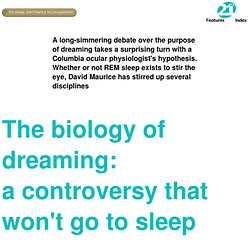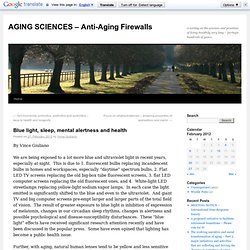

The biology of dreaming. O one would normally consider David Maurice, Ph.D., professor of ocular physiology in the Department of Ophthalmology at Columbia-Presbyterian Medical Center, a revolutionary.

Nevertheless, he has reignited a decades-long controversy that could spark a revolutionary re-evaluation of an entire field of behavioral research. Dr. Maurice has developed a startling new line of scientific inquiry that, when added to other findings, could change our understanding of rapid eye movement (REM) sleep and the nature of dreams. What Maurice has done is to suggest an alternative explanation for the phenomenon known as REM sleep, the stage in which the eyes rapidly move and most dreams occur. Dr. "Without REM," Maurice told 21stC, "our corneas would starve and suffocate while we are asleep with our eyes closed. " Maurice's interest in REM began a few years ago. Really? Using a Computer Before Bed Can Disrupt Sleep. Really?

Anahad O’Connor tackles health myths. In today’s gadget-obsessed world, sleep experts often say that for a better night’s rest, Americans should click the “off” buttons on their smartphones and tablets before tucking in for the night. Electronic devices stimulate brain activity, they say, disrupting your ability to drift off to sleep. But according to the National Sleep Foundation, more than 90 percent of Americans regularly use a computer or electronic device of some kind in the hour before bed. Increasingly, researchers are finding that artificial light from some devices at night may tinker with brain chemicals that promote sleep. In the study, published in the journal Applied Ergonomics, the researchers had volunteers read, play games and watch movies on an iPad, iPad 2 or PC tablet for various amounts of time while measuring the amount of light their eyes received. Studies of college students using computers at night have suggested similar effects on melatonin.
Blue light, sleep, mental alertness and health. By Vince Giuliano We are being exposed to a lot more blue and ultraviolet light in recent years, especially at night.

This is due to 1. fluorescent bulbs replacing incandescent bulbs in homes and workspaces, especially “daytime” spectrum bulbs, 2. Flat LED TV screens replacing the old big-box tube fluorescent screens, 3. flat LED computer screens replacing the old fluorescent ones, and 4. White-light LED streetlamps replacing yellow-light sodium vapor lamps. In each case the light emitted is significantly shifted to the blue and even to the ultraviolet. Further, with aging, natural human lenses tend to be yellow and less sensitive to blue and UV. There is much more that meets the eye than what we see. Besides providing visual images, inputs from the eye to other body systems impact on mood, alertness, sense of wellbeing and on the integrity of circadian rhythms related to health. Image source: There are multiple body clocks. This is happening throughout the country. Sleep apnea, evolution, and breathing masks: an excerpt from David K. Randall’s Dreamland. Courtesy Jupiter Images/Pixland.

The following article is adapted from David K. Randall’s Dreamland: Adventures in the Strange Science of Sleep, out now from W.W. Norton. This is the tale of how an Australian man with a vacuum cleaner fixed a mistake in evolution. It begins in the late 1970s. Patients with sleep apnea experience a strange nightly sensation that brings the body disturbingly close to death. Eventually, the brain gets the urgent message that the body is choking. Sleep apnea was discovered when a group of American physicians noticed that some obese patients complained of overwhelming fatigue and would drift asleep unintentionally. Chronic Fatigue Syndrome: 'Surrounded by uncertainty' By James Gallagher Health reporter, BBC News When it comes to controversy and heated debate, few illnesses come close to Chronic Fatigue Syndrome, also known as Myalgic Encephalomyelitis (ME).

There have been arguments about whether it exists, the cause, the best treatments and even the name itself. These disagreements have reached the level of abuse and death threats. The disease itself, however, remains poorly understood - or as one doctor put it: "The whole thing is surrounded by uncertainty". Chronic fatigue syndrome: Brain training is most cost-effective treatment.
2 August 2012Last updated at 01:57 GMT The cause of Chronic fatigue syndrome is unknown.

Exercise and behavioural therapies are the most cost-effective and successful ways to treat Chronic fatigue syndrome, also known as ME, an analysis shows. A study of 640 patients showed these treatments had the potential to save the economy millions of pounds if they were widely adopted. The findings were published in the journal PLoS ONE. However, another treatment favoured by patients' groups was shown to offer little value. Nobody knows what causes the condition, yet a quarter of a million people in the UK are thought to have it. The symptoms include severe tiredness, poor concentration and memory as well as muscle and joint pain and disturbed sleep. Continue reading the main story. Is the Purpose of Sleep to Let Our Brains “Defragment,” Like a Hard Drive? Do science fiction and fantasy cause recurring dreams?
How Your Dreams Are Making You Smarter. [VIDEO] The Science of Lucid Dreaming. Why Daydreaming Is a Virtue.